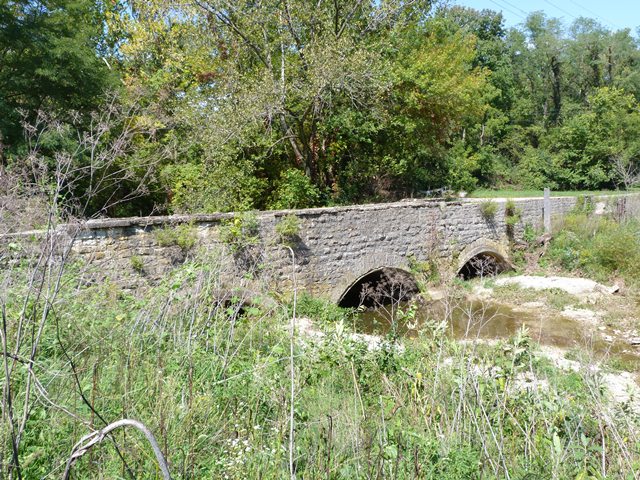We Recommend:
Bach Steel - Experts at historic truss bridge restoration.
BridgeHunter.com Phase 1 is released to the public! - Visit Now
CR-220 Southwest Bridge
Decatur County Bridge 114

Primary Photographer(s): Nathan Holth and Rick McOmber
Bridge Documented: September 22, 2012
Rural: Decatur County, Indiana: United States
By Builder/Contractor: Unknown
Not Available or Not Applicable
20.0 Feet (6.1 Meters)
71.0 Feet (21.6 Meters)
17.4 Feet (5.3 Meters)
3 Main Span(s)
1600092

View Information About HSR Ratings
Bridge Documentation
View Archived National Bridge Inventory Report - Has Additional Details and Evaluation
Although this bridge has four spans, the low rise of the arches and the shortness of these spans make this a small, low-lying bridge. The bridge's stone spandrel walls appear to retain historic integrity, but the arch ring has been altered by the addition of concrete and later a corrugated steel lining as well.
Information and Findings From DHPA Historic Bridge SurveyStatement of Significance Stone arches were not typically designed with segmental rings. Few of Decatur County's segmental stone arches are multispan and fewer yet have so little rise. Architectural Description Local craftsmen built most of Indiana's stone arches from regional materials just before or in the first fifteen years of the twentieth century. Most stonemasons preferred full-centered or semicircular arches in
which the line of pressure passes through the center of each stone in the arch ring until carried vertically into the substructure. In some cases, though, masons erected segmental arches in which the intrados is less than half a
circle. To function successfully, segmental arches require the substructure to accommodate some horizontal as well as some vertical pressure. Other Information In March 1872, the Decatur board appropriated $500 as a contribution to the Sand Creek Turnpike Company to aid in "constructing a bridge across Sand Creek on their road." The appropriation could have applied to
#114, #118, or #190. It is unclear whether local citizens in the early twentieth century considered #114 or #117 as the "Harris City Bridge." In any case, J. M. Mathews received $30 for repairing the bridge's wingwalls of the bridge
near Harris City in June 1908. In response to damages inflicted by the big 1913 flood, the commissioners accepted the plans and specifications which "J. A. Stagg, Engineer," submitted for "reconstruction of a wall" and fill of the
"Harris city bridge." McQueen and Watkins secured a $267 contract for the repair in May, and the county paid them in December. The arch rings are low and quite segmental. They are also placed under considerable fill. Bridge Considered Historic By Survey: Yes |
![]()
Photo Galleries and Videos: CR-220 Southwest Bridge
Bridge Photo-Documentation
Original / Full Size PhotosA collection of overview and detail photos. This gallery offers photos in the highest available resolution and file size in a touch-friendly popup viewer.
Alternatively, Browse Without Using Viewer
![]()
Bridge Photo-Documentation
Mobile Optimized PhotosA collection of overview and detail photos. This gallery features data-friendly, fast-loading photos in a touch-friendly popup viewer.
Alternatively, Browse Without Using Viewer
![]()
Maps and Links: CR-220 Southwest Bridge
Coordinates (Latitude, Longitude):
Search For Additional Bridge Listings:
Bridgehunter.com: View listed bridges within 0.5 miles (0.8 kilometers) of this bridge.
Bridgehunter.com: View listed bridges within 10 miles (16 kilometers) of this bridge.
Additional Maps:
Google Streetview (If Available)
GeoHack (Additional Links and Coordinates)
Apple Maps (Via DuckDuckGo Search)
Apple Maps (Apple devices only)
Android: Open Location In Your Map or GPS App
Flickr Gallery (Find Nearby Photos)
Wikimedia Commons (Find Nearby Photos)
Directions Via Sygic For Android
Directions Via Sygic For iOS and Android Dolphin Browser
USGS National Map (United States Only)
Historical USGS Topo Maps (United States Only)
Historic Aerials (United States Only)
CalTopo Maps (United States Only)

